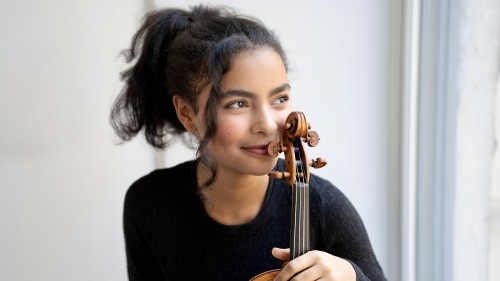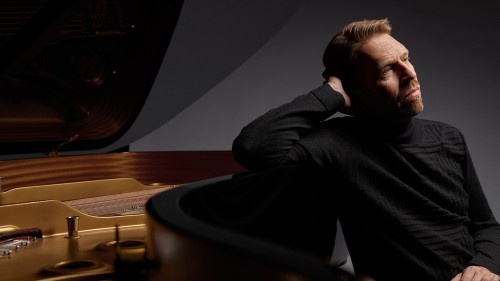
Meta4
For Those Departed
This site uses cookies to measure our traffic and improve your experience. By clicking "OK" you consent to our use of cookies.
In order to keep everyone safe as we welcome you back to performances, we are asking our patrons to provide proof of vaccination and to wear a mask to our performances. Learn more at celebrityseries.org/safety.
The ever-popular Academy of St Martin in the Fields, under the musical direction of renowned soloist Joshua Bell, returns to the Celebrity Series for the thirteenth time! This storied, conductor-less ensemble is one of the world’s finest chamber orchestras, well known for its inspired and inspiring interpretations of great orchestral music. The program includes works by Florence Price and Mendelssohn, as well as Dvořák's Violin Concerto, highlighting Bell, a superstar instrumentalist whose spectacular gifts as a soloist have earned him the reputation as “one of the most imaginative, technically gifted and altogether extraordinary violinists of our time” (The Washington Post).

Many American audiences familiar with overtures from musicals may think of them as a collection of themes from the show, a preview of what you’re about to hear. To Gioachino Rossini (1792-1868) and contemporaneous audiences, this was not the expectation. Called a Sinfonia at the time, Rossini’s overture here is simply the symphony that happens before the curtain goes up. In fact, Rossini, a consummate plagiarizer of his own work, borrowed the overture from his other operas Aureliano in Palmira and Elisabetta, regina d’Inghilterra. Its function in all of these operas is to say to the audience: take your seat, enjoy the emotion of the contrasting themes, and expect a great night of entertainment.
© Connor Buckley, 2022
Antonín Dvořák (1841-1904), in writing his Violin Concerto, confronted the same issue all composers do: how do you give a piece a sense of unity while exciting the listener? A form with such a well-trodden history as the concerto compounds this challenge: what hasn’t the audience heard? How do you design something surprising when so much can be anticipated? Dvořák’s solution was to drastically alter the basic principles of concerto form established in the Classical era. In the first movement, a concerto typically contained a tutti exposition section, where the entire orchestra would state the main theme, followed by a solo exposition section, where the soloist would restate and embellish the theme with the orchestra, and then a final developmental section that would culminate in a cadenza, a virtuosic section for soloist only. The movement would normally end definitively and there would be a pause before the second slower movement. Dvořák playfully constricted this circumscribed form, doing away with the tutti and cadenza, drastically shortening the development section, and flowing without pause into the second slower movement. The altered form pushes against virtuosic ego—with no cadenza to show off and no pause for the audience to reflect and appreciate what has been accomplished, the soloist is not thrust outward into acclaim, but drawn inward to pure music making.
The second movement showcases the strength of Dvořák’s melodic inventiveness. Beginning sedately, the melody confines itself to a limited range. Only after several minor variations does the solo violin soar to discover intense joy at its own musical expressiveness. The feedback loop continues until the second theme, a rhythmically charged section in minor that suddenly beckons the listener further into the violinist’s world. Development of the previous theme continues after as the violinist molds the material in seemingly innumerable variations, giving the listener the impression that the solo is being improvised.
The third movement begins with a kind of reveal—throughout the piece, starting at the soloist’s first notes, the audience has heard a simple motif where the melody starts, leaps down, then quickly climbs back up again. Dvořák plays with this motif throughout the first two movements, embellishing it, turning it upside down and backwards to emphasize both the unity and freshness of the music. The final movement seems to demonstrate that this was part of a full melody all along and that Dvořák had been preparing the listener for what was to come. The melody in this case is based on a dance called the furiant from the Czech tradition, Dvořák’s own culture. The composer constantly borrowed from this system of folk music to show its sophistication. Here, it provides a deep sense of delight, allowing the violinist to fully showcase their technical prowess over fast, constantly evolving, rhythmically buoyant music and to finally celebrate the inherent joy in virtuosity.
© Connor Buckley, 2022
Florence Price’s story has now been told many times over, and the world of classical music is better for it. Although she was a stellar talent and the first Black woman to be recognized by a major orchestra, Price was not given close to the attention she deserved in her lifetime. In fact, many of her manuscripts were nearly lost before being discovered in 2009 in her old summer home, where for years they sat unattended in boxes in an attic. Real widespread appreciation and performance of her music has only occurred in the last few years.
Much of Price’s work reflects the canon of the Black church and its spiritual practice through music. She arranged many songs taken from the Black Christian tradition, and in this case composed a work for organ that reflects the essence of musical devotion in the sanctuary. Arranged here for violin solo and orchestra by Jim Gray, the piece takes on a different character, revealing Price’s love for and expertise in the idioms of the Romantic era.
© Connor Buckley, 2022
From 1829 to 1831, Felix Mendelssohn traveled on what is known as the “grand tour,” a trek through Europe that became a rite of passage for all would-be sophisticants of the time. Mendelssohn spent his time touring England, Scotland, Wales, and, essential for any artist, Italy, composing as he traveled. During this time, the composer wrote some of his most famous pieces, including his Symphony No. 3, “Scottish”, the Hebrides Overture, and this evening’s piece, his Symphony No. 4, “Italian.”
Written less as an ode to the music and culture of Italy and more as a record of the emotional impact of his trip, the Italian Symphony is one of Mendelssohn’s most joyous works. The almost incomparably famous first theme is a testament to this, as well as to the composer’s incomparable ability to develop a melody. What Mendelssohn essentially does in this first movement is repeat sections of his joyful theme again and again, creating variety by passing it between different instruments, changing the harmonic accompaniment, lengthening notes, and dramatically altering the loudness of the orchestra. A committed Classicist, Mendelssohn strictly but expertly follows the first movement sonata form standard in a Symphony: the theme is stated, the theme is developed, the theme is restated more grandly.
Equally remarkable is Mendelssohn’s pristine efficiency, a sense that carries through from the first movement into the second. Like the first, the second movement is at its core the exploration of a single melody. With the melody relatively static and the forward-leaning staccato bassline a relentless presence, small variations in the accompaniment and orchestration amplify in importance and draw the audience to listen intently. The broad, legato second theme serves as a direct counterpoint to the crisp bassline that accompanies the original melody, lending a captivating freshness when the first melody returns.
The third movement, a minuet, takes aspects of the legato second theme from the previous movement and extends them. Apparently written to echo the proportional beauty of the architecture Mendelssohn saw in Italy, the melody envelops the listener in stately stillness while the accompaniment, moving at twice the speed, pushes the form forward to retain interest. Later, the music evokes the upright nature of military music as horns join the strings in a march-like theme.
The intensity with which the fourth and final movement begins belies its fundamental characteristic, its unrelenting joy. The most clearly Italian section of the Symphony, the finale is a stylized version of the Neapolitan dance called the saltarello. It is an ecstatic piece of music. After three movements of melodic contrast, the Saltarello never lets up its self-contained rapture even at its quietest moments. At 5 minutes in length, it is a final argument from the composer for the impactfulness of concise forms when they are used to full effect. Punctuating the Symphony as a whole, Mendelssohn repeats the theme from the first movement in minor, bringing it full circle to a raucous and satisfying conclusion.
© Connor Buckley, 2022
“At the end of the day, we’re just looking for good music. For over 60 years, the Academy of St Martin in the Fields has provided us with exactly that.”
CLASSIC RADIO BOSTON
“But while there's no doubt Bell's phenomenal technique and tone justifies his superstar status, he also shows an uncommon degree of self-effacement… Bell's relationship with the orchestra has become symbiotic.”
THE GUARDIAN
This performance is made possible in part by support from Celebrity Series' LIVE PERFORMANCE! Arts for All Endowment Funds, with generous leadership support from Susan & Michael Thonis. Additional support provided by Katie & Paul Buttenwieser.

For Those Departed

Debut Series


In the Footsteps of Piazzolla
Debut Series


Clarinetist Christopher Elchico & Friends
Stay in touch with Celebrity Series of Boston and get the latest.
Email Updates Sign up for Email Updates